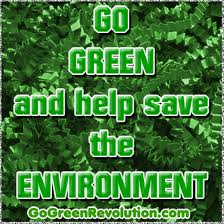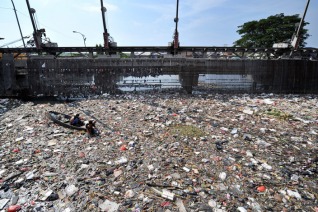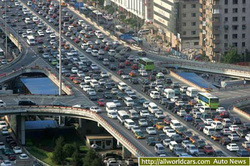Save The Environment!

We desperately need to save the Environment every second the Earth is getting polluted by poisonous gases and fumes made by cars and factories. If we carry on to pollute this much what will happen to our kids? How will they live? Just ask these questions to yourself and think .But WAIT! We can stop the earth from getting polluted by choosing Eco friendly things, its really simple like, instead of getting plastic bags from the supermarket which takes over a 1000 years to compose into waste you can just buy a reusable bags which turn out to be much cheaper and can carry more things and last longer! Or use sustainable forest paper or solar power instead and plant trees. There are so many things you can do! We don't want our rivers which we get water from to look like this!
The effects are still reversible!
Despite all of the damage we have caused the environment most of it is reversible. We can restore habitats and return species to them, clean rivers, renovate buildings, replenish the topsoil, replant forests. However, these activities do not slow the worst affects of the damage made. We still have to fix the source of these problems.
Why we should save the Environment!
The Environment is the most important resource for life.
We get water,power and Oxygen from the Environment.
It helps to clear pollution and is a large habitat for animals.
We get lots of resources from there but if we use too much and it doesn't come from sustainable forests
we may run out of resources.
Which is not good.
1. Food and climate change
you may think that food does not play a big roll in pollution but it does
scroll down and read what pollution it causes.
The Environment is the most important resource for life.
We get water,power and Oxygen from the Environment.
It helps to clear pollution and is a large habitat for animals.
We get lots of resources from there but if we use too much and it doesn't come from sustainable forests
we may run out of resources.
Which is not good.
1. Food and climate change
you may think that food does not play a big roll in pollution but it does
scroll down and read what pollution it causes.
It's not only how we choose to travel or heat our homes that shows our carbon footprint. The food we eat also has a climate impact. Understanding the resources that go into producing our food can make us more aware of the link between food and climate change.
As both the world's population and technological becoming more effective increase, the way and scale in which food is produced has changed . There are 7 main ways that contribute to food's climate impact, including: how low on the food chain it is, how much energy is used to produce it (and whether the food is grown organically or with chemical fertilizers), and how far the food has to travel before it gets to the table.
As both the world's population and technological becoming more effective increase, the way and scale in which food is produced has changed . There are 7 main ways that contribute to food's climate impact, including: how low on the food chain it is, how much energy is used to produce it (and whether the food is grown organically or with chemical fertilizers), and how far the food has to travel before it gets to the table.
2.Meat and Climate Change
Making Meat is a large contributor to climate change. It is thought that livestock and farming land uses and takes 30 per cent of the land surface of the planet. Because of their large numbers, livestock produce a large amount of greenhouse gases (such as methane and nitrous oxide) . In fact,It is estimated that livestock production is responsible for 18% of greenhouse gases. The growing of livestock and other animals for food is also an extremely inefficient process. For example, it takes approximately five to seven kilograms of grain to produce one kilogram of beef. Each of those kilograms of grain takes some energy and water to produce, process, and transport.
3.The problems with chemical
Farming
Other farming practices can impact the climate. Pesticides and fertilizers are widely used in farming, and are often made from fossil fuels. Manufacturing and transporting these chemicals uses some amounts of energy and produces greenhouse gases.Studies have shown that chemical farming uses more energy than organic farms, which do not use these chemicals. In addition, the use of nitrogen fertilizers in soils produces nitrous oxide, a greenhouse gas that is approximately 300 times more powerful than carbon dioxide at trapping heat in the atmosphere.
Organic farms, on the other hand — which rely on natural manure and compost for fertilizer — store muck more carbon in the soil, keeping it out of the atmosphere.
Important fact
Food that's closer to home Where your food comes from is also important. Currently, the average meal travels 1200 km from the farm to plate. Food that is grown closer to home will have fewer transportation emissions and also be fresher and support local farmers. And as the distance food travels decreases, so does the need for processing and refrigeration to reduce spoiling the food.
Choosing to buy food that is organically grown can therefore be a better choice for the climate. But if possible, buy food that that is organic and local.
Ways to help stop pollution!
1. Reduce, Reuse, Recycle
Do your part to reduce waste by choosing reusable products instead of disposables. Buying products with minimal packaging (including the economy size when that makes sense for you) will help to reduce waste. And whenever you can, recycle paper, plastic, newspaper, glass and aluminum cans. If there isn't a recycling program at your workplace, school, or in your community, ask about starting one. By recycling half of your household waste, you can save 2,400 pounds of carbon dioxide annually.
2.Walk and save money!
Walk to school instead of driving in a car! this will save money,fuel,and pumps less carbon dioxide in the air.
Farming
Other farming practices can impact the climate. Pesticides and fertilizers are widely used in farming, and are often made from fossil fuels. Manufacturing and transporting these chemicals uses some amounts of energy and produces greenhouse gases.Studies have shown that chemical farming uses more energy than organic farms, which do not use these chemicals. In addition, the use of nitrogen fertilizers in soils produces nitrous oxide, a greenhouse gas that is approximately 300 times more powerful than carbon dioxide at trapping heat in the atmosphere.
Organic farms, on the other hand — which rely on natural manure and compost for fertilizer — store muck more carbon in the soil, keeping it out of the atmosphere.
Important fact
Food that's closer to home Where your food comes from is also important. Currently, the average meal travels 1200 km from the farm to plate. Food that is grown closer to home will have fewer transportation emissions and also be fresher and support local farmers. And as the distance food travels decreases, so does the need for processing and refrigeration to reduce spoiling the food.
Choosing to buy food that is organically grown can therefore be a better choice for the climate. But if possible, buy food that that is organic and local.
Ways to help stop pollution!
1. Reduce, Reuse, Recycle
Do your part to reduce waste by choosing reusable products instead of disposables. Buying products with minimal packaging (including the economy size when that makes sense for you) will help to reduce waste. And whenever you can, recycle paper, plastic, newspaper, glass and aluminum cans. If there isn't a recycling program at your workplace, school, or in your community, ask about starting one. By recycling half of your household waste, you can save 2,400 pounds of carbon dioxide annually.
2.Walk and save money!
Walk to school instead of driving in a car! this will save money,fuel,and pumps less carbon dioxide in the air.



